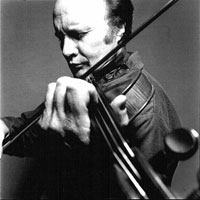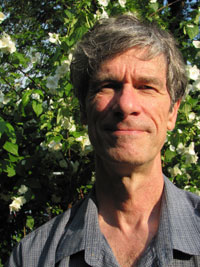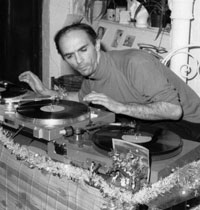Jazz: Different Perspectives, La Médiathèque Jazz of the MIJF, Off the Record by Marc Chénard
/ November 1, 2011
Version française...
Flash version here.
Different perspectives
More often
than not, the coverage of music in print is geared primarily towards
an audience of converts. Journalists specializing in a given genre,
for instance, assume that they and their readers share common interests
and values, even if they recognize that viewpoints vary greatly in accordance
to individual experiences and knowledge. But since everyone is not of
the same musical persuasion, how then do we deal with the views of others,
performers and listeners, whose preferences simply lay elsewhere? Have
they not something of value to say to devotees of a given genre when
they offer differering opinions that may well shed new light on truths
taken for granted?
La Scena Musicale
recently decided to test these waters by talking to three musicians
of our city about jazz. The following three questions were asked, each
of these reminding us that music, unlike science, is a matter
of conjectures rather than absolutes.
1. What
is (or are) its strengths?
2. What is (or are) its weaknesses?
3. Does this music have any influence on your way of making music?
 Malcolm Goldstein Malcolm Goldstein
Violinist, improviser, performer and composer
1. Jazz music
remains vibrant and vital, and it still produces musicians who embody
these qualities. However, this depends on how you define jazz. What’s
taught at Berklee or in music conservatories is not jazz, because these
institutions stifle creativity rather than encouraging it.
2. Personally,
I don’t think it has any.
3. I have
to admit that jazz does not influence me. “To influence”, what does
that mean? Like so many other types of music — Western or other —
it is just part of my life. I worked once with Ornette Coleman, he wrote
a piece for me. I’ve lived in Montreal for 20 years, and I must mention
that this city has a particularly good environment for music making.
I see here a degree of fluiidty between the different musical communities,
which sets it apart from other places, like Europe, where everything
is so much more compartementalized.
 Michel Gonneville Michel Gonneville
Composer, professor at the Montreal Conservatory of Music and
Drama
1. Jazz’s
strength is that there has always been someone who comes along and surprises
us, who shakes up our listening habits. Sometimes, it might be a single
piece or a series of them, a subtle detail or a well thought-out harmonic
scheme, maybe an unusual rhythm, a distinct instrumental timbre or a
neatly crafted arrangement. It openness to other styles has at times
allowed it to follow new paths, renewing itself in the process. But
once absorbed these influences are quickly imitated in a makeshift way,
and melt away in a din of musical sounds.
2. The weaknesses
of jazz are found in how it has standardized itself, in its institutionalization,
with all of its fixed forms that lack both imagination and a spirit
of renewal, routines, if you will. At times it lacks subtlety and true
craftsmanship, with a tendancy to fall back on technical or instrumental
virtuosity dependant on pre-prepared riffs devoid of any “feeling”.
Mind you, no genre is immune from such pitfalls, not even written contemporary
music., are certainly not vocal, folk and other world musics. Jazz is
a bit like the church, it has strayed from its origins. It too bears
a history of its own, with its classics, masters an so on. You see,
classical music does not have the exclusive preserve of such terminology,
and jazz has also found its way into higher education with its codified
recipes, and what not. Academia, therefore, threatens jazz as much as
it does all the other genres. The weakness of jazz is in the mind, in
the ideas held by some of its representatives, and no “instinct”
whatsoever can fully save it from that fate.
3.
As a listener, I always like to discover what’s new, whether in jazz
or elsewhere. Since I am a professional composer by trade, and not a
performer, I have brought in something of jazz in one of my pieces,
perhaps naively, drawing on progressive rock elsewhere, or simply remaining
“traditional” in others. The important thing for me was not to copy
the source of inspiration to the letter precisely capture, but to absorb
and integrate within the piece and in accordance with my feelings.
 Martin Tétreault Martin Tétreault
Turntablist, sound experimenter and improviser
1. When I
use turntables, my relationship to jazz comes from the playing and mixing
of sounds from vinyl records, not from musicians, styles or eras. I
mostly appreciate the solos because they are easy to pick out for use.
Drummers come out on top for me in this regard.
2. I’m hesitant
to say if it’s a weakness, a mistake or a lack of taste, but I have
a lot of difficulty with arrangements that “jazzify” classical works,
not even those that Don Sebesky did at one time (like the Concerto for
Aranjuez). I’ m rather uncomfortable with that. It might have to do
with Moe Koffman’s version of Vivaldi’s Four Seasons, but at least
there’s a drum solo in it.
3. Improvisation
is the main influence of jazz on me. I discovered this by working with
the Ambiances Magnétiques crowd. Once you have improvised alongside
Jean Derome, René Lussier, Michel-F. Côté, Diane Labrosse, this way
of making music leaves its mark on you forever.
Interviews by
Marc Chénard
Translation:
Lynn Travers
La Médiathèque
Jazz of the MIJF: One year later
by Marc Chénard
La Médiathèque
Jazz of Montreal’s jazz festival (aka the FIJM) which opened its doors
in June 2010, recently concluded an agreement with the family of the
late Len Dobbin to acquire his extensive collection. (For those who
may may not know, the departed was known as the long-time jazz friend
of Montreal, and his death coincidentailly occurred in July 2009 during
the festival).The Mediathèeque’s director, Serge Lafortune, states
that his heirs have agreed to donate the bulk of his considerable collection,
which includes some:
12,000 CDs
400 tape recordings of concerts and interviews
600 books (biographies, monographs, musicological studies)
3,200 copies of some 40 periodicals, some dating from the 1950s
5 boxes of archival documents and business communications
3 boxes of manuscripts and typescripts
Hundreds of artefacts, among them show tickets and souvenir concert
programs
Impressive as this
amount of material is, there is a Herculean task ahead. “We received
everything all jumbled up together in about 120 boxes,” notes Mr.
Lafortune. “So far we have sorted out and organized the magazines,
but a complete indexing of the collection and the online information
will not be happening soon, believe me.” At the moment the vast majority
of items are stored in its vault, alongside the festival’s own archives,
but a number of Dobbin’s treasures are on display in showcases its
reading room.
Available for on-site
public consultation are some 800 books, shelves of compact disc recordings
and 11 viewing stations giving access to the festival’s filmed concerts.
. As well, one can now view, for free, a selection of unabridged concerts
on a big screen in the Stevie Wonder Room (on the second floor of the
same buliding), the showings taking place on Wednesday evenings at 7
p.m. (see link to website below for information on dates and concerts).
For all the festival’s current commercial success, it has also
left us with a great legacy of outstanding music, all of which
are not just mere passive memories, but active assets within our cultural
heritage.
Third floor, Maison
du Festival Rio Tinto Alcan (305 St. Catherine Street East )
Library hours: Tues 11:30 am to 6 pm, Wed-Sat 11:30 am to 9 pm,
Sun 11:30 am to 5 pm.
Information: 514-288-8882, ext. 4.
www.montrealjazzfest.com (Tab “Maison du Festival Rio Tinto Alcan”
at right.)
Translation:
Lynn Travers
Off the record
by Marc Chénard & Mark Chodan
Montreal adventures
Thom Gossage Other
Voices : In Other Words
Songlines SGL 1591-2 (www.songlines.com)

Drummer Thom Gossage is among the more forward-looking musical thinkers
on our local scene today, and his very original and fresh-sounding music
is proof of that. Over the last ten years he has produced five CDs as
leader of the Other Voices quintet, including this newly released title
on Vancouver’s Songlines label. In the past this group would always
push the envelope with each recording,, and this new one takes a couple
of more steps ahead. The music — which is of a truly collective spirit
without ever falling completely into free-form improvisation — brilliantly
blurs the traditional dividing line between composing (the charts all
written by the leader ) and improvisational playing, resulting in a
chamber-like music that oversteps all conventional forms of jazz. The
drummer is to be congratulated for having explained this approach in
the liner notes (and listeners should also read a longer interview with
him posted on the label’s website). Aiding and abetting Gossage are
saxophonists Rémi Bolduc (alto) and Frank Lozano (tenor and soprano)
and rhythm section partners Steve Reagele (guitar) and Miles Perkin
(bass), all of whom are fully engaged in the cause. While this music
may confuse some at first, it requires very close and repeated listenings.,
something of rarity in jazz nowadays, where conventional formulas abound.As
for highlights, it is almost impossible to single any one throughtout
the nine tracks on this 58-minute album that is at once well-reorded
and well-mixed to enhance everydetail and nuance in it. The sum is simply
greater than its constituent parts, and this album merits a good half
star more on the merits of its concept and performance. MChé
Tilting: February
9, 2011
Autoproduction de l’artiste

As a musician heavily involved in the city’s current contemporary
jazz scene, bassist Nicolas Caloia is an organizer of musical projects,
the most ambitious of these being his 30-piece ensemble, the Ratchet
Orchestra. More modest, however, is his quartet Tilting that comprises
such Montreal stalwarts as Jean Derome (alto and baritone saxes, bass
flute), pianist Guillaume Dostaler, and drummer Isaiah Ceccarelli. While
imbued with a certain edge, reminiscent in some ways of the 1960s, this
music is neither nostalgic nor backward-looking. Caloia’s musical
aesthetic places him at the crossroads of late hard bop — with its
simply crafted themes and rhythmic instensity — and early free jazz,
characterized by long exploratory solos (mainly by Derome), albeit not
quite over the top. Underpinned by an insistent bass, the saxophonist
gets feisty in spots, but there’s some respit as well, as in the-the
third of the four pieces of this side, the ballad-like,“Stare”,.
Recorded last February in one of Montreal’s Maisons de la culture,
this ensemble is devoid of the habitual veneer that characterizes so
many jazz performances nowadays, a strength that makes this group qualify
as a direct descendant of the best free bop bands of yore. As a result,
this music is never slick, but full of vital energy. Self-produced by
the leader, this album might be hard to locate in stores, but do make
a point of catching this band at their next show. MChé
New-york pianos
Matthew Shipp:
The Art of the Improviser
Thirsty Ear THI 57197 (www.thirstyear.com)

Ever since the early days of his career in the 80s, pianist Matthew
Shipp has frequently been compared to Cecil Taylor. Beyond the fact
of being both ferociously outspoken when discussing what they do and
uncompromising as leaders, further parallels are generally weak, especially
in terms of style. Both musicians have split their careers equally between
ensemble and solo playing, and that may be where the comparisons should
end. This 2 CD set documents Shipp live, in both of his favourite settings.
The first disc showcases him in a trio with Michael Bisio (bass) and
ex-David S. Ware Quartet colleague Whit Dickey (drums), while the second
is a solo performance. Much of Shipp’s music comes across as dense
blocks of sound, his improvising cast as a dialogue with the masses
of sounds. The solo performance is essentially a suite of some of Shipp’s
best known pieces linked by improvisations that the pianist himself
describes as a kind of channeling of the cosmos. It is a strong performance
with fewer tendencies toward getting tied up in musical knots as Shipp
sometimes does. His music is very complex and navigating it can understandably
be a feat in itself. The trio disc for its part is no less declaratory.
Dickey is a sympathetic partner for Shipp with his own intricate sound
space. Although Bisio is a new addition to the trio, he sounds at home
offering lyrical support, especially while Shipp has the low end covered.
As usual, the leader asserts his voice in unquestionable terms. I can
think of another musician with the same disposition… C.T.
MCho
Craig Taborn:
Avenging Angel
ECM 2207 (www.ecmrecords.com)

Every once in a while a recording comes along that is refreshingly original,
not only in a given genre but even by the artist’s own standards.
Craig Taborn is best known as the pianist in James Carter’s quartet
of the 1990s. His activity since moving to NY in the last decade has
been conspicuously more adventurous, but mostly in the capacity of a
sideman. After two piano trio recordings and a quartet with heavy electronic
influences, his fourth release Avenging Angel is a solo performance,
gorgeously recorded up to the ECM label’s usual standards. Taborn
is an extraordinarily gifted pianist and musician, blessed with such
facility on his instrument that he often runs the risk of falling back
on his technical skills at the expense of musical exploration. The beauty
of this performance is its capriciousness and its conscious retreat
from unnecessary virtuosity. Several of the pieces are sparse and give
the impression that he is playing only the crests of some monumental
but unstated underlying movement. Others explore the heavily contrapuntal
approach found on earlier recordings (improvising over rhythmically
complex vamps). The overall mood is introspective but there is a sense
of great depth below the serene surface. I hear traces of Lennie Tristano’s
phrasing, and some use of the harmonic language of Messaien and Ligeti,
but, most importantly, I hear Taborn. Highly recommended. MCho
Toronto tones
by Alain
Londes
Fern Lindzon:
Two Kites
Iatros 2011 (fernlindzon.com)

Vocalist Fern Lindzon’s album exudes a feeling of lyrical relaxation
as she canvasses a well-rounded collection of songs. The mood is conveyed
from the first chord of the opening piece “Distance”. Lindzon is
perfectly in tune with her band, especially Mike Murley’s tenor sax.
Of the many numbers penned by Antonio Carlos Jobim, “Two Kites”
is a hidden gem with English lyrics. It is a fitting title track that
evokes space, air, and freedom, an uncluttered zone suffused with the’
sense that “we can fly.” Lindzon takes care of the lyrics while
a background chorus soars with the rest of the band, undulating on the
wind along a melody line not unlike Miles Davis’s “Four”. The
bossa nova surfaces again with an original composition “All Fall Down”
and João Donato’s “At Quem Sabe”, sung in Portuguese. Lindzon’s
delicate pianisms backed by George Koller’s bass lead the way for
the vocalist to add her own lyrics to “Moon In the Sky”, which segues
smoothly into an easy 4/4 swing of Rodgers & Hart’s “My Romance”.
An extended 11/4 meter underpins the Yiddish art song “Dona Dona”,
supported by some beautifully lyrical soprano sax from Murley. Bill
Evans is a big inspiration for Lindzon, as we hear in her piano work
on “Grey Green”. Even if it conjures up “Blue and Green”, she
fingers it with a personal touch. Next is an infectious musical blend
of old Klezmer and contemporary jazz in the “Yam Lid” medley, a
prelude to the closing bonus track, the 70s pop tune “If He’s Ever
Near”. Overall this disc achieves a fine balance between Lindzon’s
lyrical voice and the backing of her talented band. Its upbeat feel
is like a fresh message of love very much needed for the times we live
in.
Mark Segger Sextet:
The Beginning
18th Note Records 2011 (marksegger.com)

By definition the avant-garde presents itself outside of the mainstream;
listeners are invited to focus on music that evolves in unpredictable
ways. Drummer Mark Segger has assembled diverse musicians who draw upon
a wide range of textures, giving stamp to their sound without ever becoming
cacophonous. With this debut Segger, a native of Edmonton, now seems
poised to assert his authority in Toronto. The band’s frontline is
made up of Jim Lewis (trumpet), Chris Willes (tenor or clarinet), and
Heather Segger (trombone), with able backing provided by Segger, bassist
Andrew Downing, and Tania Gill on piano and occasionally a wistful melodica.
As the ear is naturally drawn to structure, “Steam Engine” rewards
its listeners with repetitions of its signature chugging sound. Most
of the pieces, however, eschew sameness by incorporating a number of
abstract vignettes. “Part III” includes snippets slightly reminiscent
of some of the old James Bond soundtracks but with a jazzier level of
complexity: it’s as if the band were putting together a Rubik’s
cube of sidestepping melodies and countermelodies. Drawing on the rhythmic
soca beats of Trinidad and Tobago, Segger allows his musicians to explore
freely on “Soca You Play It”, whether in Jim Lewis’s solo or when
the horns play in both parallel and countering directions. In contrast,
the title track is a long, contemplative study in sustained tones from
the bass and piano, punctuated by horns that enter independently of
one another. This track develops into a dreamy sequence of distinctive
instrumental combinations and wide-ranging soundscapes. Taken as a whole,
this disc marks a true ‘beginning’ for Segger, a talented young
Canadian instrumentalist and composer who presented this project at
Montreal’s Off Jazz Festival only last month.
Version française... |
|


